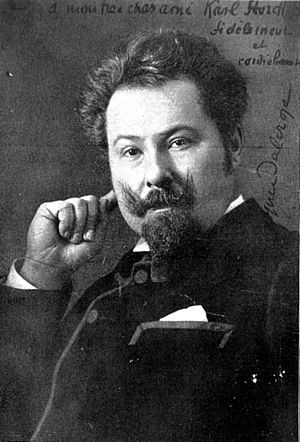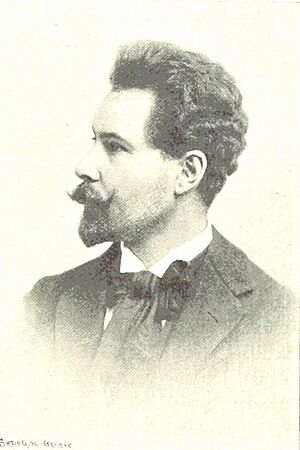Émile Jaques-Dalcroze facts for kids
Quick facts for kids
Émile Jaques-Dalcroze
|
|
|---|---|
 |
|
| Born |
Émile Henri Jaques
6 July 1865 |
| Died | 1 July 1950 (aged 84) Geneva, Switzerland
|
| Nationality | Swiss |
| Occupation |
|
| Known for | Dalcroze eurhythmics |
Émile Jaques-Dalcroze (born July 6, 1865 – died July 1, 1950) was a Swiss composer, musician, and teacher. He created a special way of learning music called Dalcroze eurhythmics. This method helps people understand and feel music through movement.
Dalcroze's method teaches musical ideas using body movements. It helps students express music naturally. He believed that turning your body into a "musical instrument" was the best way to build a strong musical foundation. The Dalcroze method has three main parts: eurhythmics, solfège, and improvisation. Dalcroze thought these three parts were key to becoming a complete musician. When used together, they make learning music fun and creative through movement.
Dalcroze started teaching at the Geneva Conservatory in 1892. He taught harmony and solfège. It was in these classes that he began trying out his new teaching ideas. Between 1903 and 1910, Dalcroze started showing his method to the public. In 1910, he opened a school in Hellerau, near Dresden, Germany. Many musicians came to learn from him. However, the school had to close when World War I started in 1914. After World War II, his ideas were used in British schools as "music and movement" lessons.
Contents
Biography
Émile Henri Jaques was born in Vienna in 1865. He later added "Dalcroze" to his name. His mother was a music teacher, so he grew up surrounded by music. He started formal music lessons when he was very young.
When he was 10, his family moved to Geneva, Switzerland. In 1877, Dalcroze joined the Conservatoire de Musique. He also studied at the College of Geneva, but he didn't like it much. He felt the college was like a "prison" because it focused only on rules, not on what students were interested in.
In 1881, he joined a student group called the Belles-Lettres Literary Society. This group focused on acting, writing, and performing music. At this time, Dalcroze was more interested in composing music. In 1884, he studied composition with famous composers like Léo Delibes and Gabriel Fauré. He also worked as an assistant conductor in Algeria in 1886. There, he discovered Arab folk music. This made him realize that different types of music had unique rhythms and styles. This idea helped him create a new way of writing music. In 1887, he studied at the Conservatory of Vienna.
Dalcroze became a Professor of Harmony at the Conservatoire de Musique de Genève in 1892. But in 1910, he left to start his own school in Hellerau, near Dresden. Many important modern dancers of the 1900s studied there, including Kurt Jooss and Mary Wigman. In 1911, Dalcroze and his students were invited to show their work in Russia. His work even inspired the famous theater director Stanislavski. Dalcroze's work was also part of the art competition at the 1912 Summer Olympics.
Dalcroze returned to Geneva in 1914 to open a new institute. In 1920, the school moved to Helleray Laxenburg, near Vienna. Sadly, it was later closed by the Nazis. Dalcroze passed away in Geneva on July 1, 1950.
Educational Philosophy
Dalcroze wondered why music theory was often taught without connecting it to sounds, movements, or feelings. He also questioned if just learning finger techniques on an instrument was enough for a full music education. He noticed that the qualities of a true musician were rarely taught in music classes.
Dalcroze believed that the first instrument to train in music is the human body. He created ways to combine listening with physical responses. He did many experiments with his students to help them learn and feel music. His main goal was to help students "hear" music in their minds. This would help them think, read, and write music without needing an instrument.
He noticed that students who struggled to play music in time could walk in time easily. He also saw that some of his best students would tap their feet or move their bodies to the music. This physical response was natural for people of all ages and cultures.
Dalcroze also observed that students would change their movements when music got louder (crescendo). They would also relax their muscles at the end of musical phrases. Since they seemed to feel the music's effects, he realized that the students themselves were the true instruments, not the piano.
Dalcroze Eurhythmics
Dalcroze saw that his students often understood music in a mechanical way, not a musical one. They couldn't hear the harmonies they wrote in theory class. They also struggled to create simple melodies. This meant they lacked musical feeling, which caused problems when they performed. His goal was to help students develop skills to feel, hear, create, imagine, connect, remember, read, write, perform, and interpret music. He wanted to help his students connect their minds and bodies, feelings and expressions.
Dalcroze realized that rhythm and movement are the parts of music most connected to our senses. He found that the speed and loudness of music depend on movement. He believed that our muscles were the best models for these. He felt that all speeds of music could be felt and understood through the body. He was sure that combining intense listening with body movements would create a powerful musical experience.
Dalcroze needed a place to test his ideas. He worked with students and created his own workspace. He looked for ways to turn music into a practical teaching tool. The ideas and methods he developed were so new that he gave them a special name: eurhythmics.
At first, Dalcroze thought the solution was to teach musicians to tense and relax their muscles at specific times and with specific force. He created exercises to help students feel the beat and rhythm through movement. He would play music and ask students to walk as they felt the pulse. He noticed that students had trouble with different speeds. He realized there needed to be a quick way for the brain to tell the muscles what to do.
Goals of Dalcroze Eurhythmics
- Mental and emotional: To help students become more aware, focus better, work well with others, and express musical feelings.
- Physical: To make performing music easier and more accurate. To help students express themselves through movement.
- Musical: To develop quickness, precision, and comfort in music. To help students respond expressively to music when listening, analyzing, writing, and improvising.
Dalcroze Eurhythmics uses three main ideas:
- Eurhythmics – This is about expressing music through movement. Students learn rhythm and how music is built by listening and moving their bodies.
- Solfège – This helps students train their ears and learn to sing music by sight. Dalcroze used a "fixed-do" system, meaning "do" was always C. He believed all children could eventually develop perfect pitch (the ability to name any note just by hearing it).
- Improvisation – This means creating music on the spot using instruments, movement, and voice.
Techniques of Dalcroze Eurhythmics
In 1905, Dalcroze created thousands of games and exercises. These combined beautiful music, careful listening, and spontaneous movement. He believed that teachers should be able to make up songs for activities in music class.
The movements Dalcroze used included different ways of moving, standing, and gesturing. These movements helped express the speed, length, loudness, accents, and other parts of music's rhythm.
See also
 In Spanish: Émile Jaques-Dalcroze para niños
In Spanish: Émile Jaques-Dalcroze para niños


